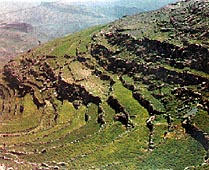
Agriculture in Yemen [Archives:1999/47/Business & Economy]
November 22 1999
By: Ismail Alghaberi
Yemen Times
Agriculture is always connected with man. Without man and his efforts, the whole country would be nothing more than barren pieces of land. It is one of the most important economic resources for countries that helps achieve development and self-reliance. Land’s life is simply man’s life, and history shows us that many civilizations lived, depending solely on arable lands. In olden times, people used to travel a lot in pursuit of lands that could be cultivated. In other words, they were in pursuit of life.
Today, about 75% of the population in Yemen depends on their land and fields for living. Many indicators show a remarkable development in the field of agriculture in Yemen.
Lack of water resources.
Yemen is one of the countries suffering from water shortage. About 80% of the arable land depends on rain for irrigation. Rainfall rates in these areas fluctuates and exploiting rainfall for irrigating lands is not effective. What is worse is that, water reserves are used carelessly. In addition, wells are dug randomly, ignoring the dangerous consequences of such actions.
Irrigation reservoirs

Agricultural sector and food security
Since the 70s, food security has become a worry for many advanced as well as developing countries. The main reason is the impossibility of controlling productivity. There are many factors that help cause productivity fluctuations such as rainfall, temperature, moisture and many others. However, a great part of these factors can be controlled.
The wide gap between volume of production and consumers’ needs is really the main challenge to our society. The agricultural sector has been able to meet consumer’s demands of fruits and vegetables. However, it is not yet able to meet their demands for crops, white wheat, or other food products. The inability to achieve self-sufficiency in this regard can be attributed to reasons such as:
I) About 80% of the arable land depends on rain for irrigation.
II) The increase in growing qat which covers about 25% of the arable land.
III) Population increase.
IV) The unfair price policy that discourages farmers from growing corps.
V) The absence of private sector investment in the field of agriculture.
However, the agricultural sector has elements which qualify it to play a crucial role in achieving food security. What it needs is wise guidance that will set it on the right course to make it able to meet the increasing needs of the increasing population.
Desertification
Reports show that about 97% of the Yemen’s arable land is threatened by desertification. Some of the reasons are:
I) The expanse of sands on arable land as a result of the lack of rain especially in Wadi Zabid and Wadi Rima in Tihamah and Abyan.
II) Woodcutting and grazing. Treeless areas are easily desertified. Trees can be a strong wall against expanding sands. Unfortunately, most of the trees were destroyed by woodcutters unaware of their wrongdoing.
The concerned authorities have realized this problem early and took suitable steps to avoid the disaster. Many trees and plants are being planted to prevent further expansion of sands. Defensive barriers are also being constructed for the same purpose.
Pest control
Pests are one of the main threats to plants. They may destroy all production. To avoid such damages, farmers should follow agronomists’ instructions with regards to the suitable times of planting, watering, etc.
Agricultural researches
Researches done by the General Authority for Agricultural Research and Guidance have achieved remarkable success. For example:
I) Conducting research to guide farmers.
II) Planting new types of plants with high productivity.
III) Controlling pests.
IV) Specifying the amount of water needed to irrigate some kind of plants.
Although it is newly established, the Authority has been able to maintain a remarkable position among other Arab authorities in the same field. It has been able to achieve the second position and get the second prize for the best research among 102 other researches presented by 13 research centers. Moreover, new agricultural techniques have been implemented and this has helped improving both quantity and quality of products.
——
[archive-e:47-v:1999-y:1999-d:1999-11-22-p:./1999/iss47/b&e.htm]


